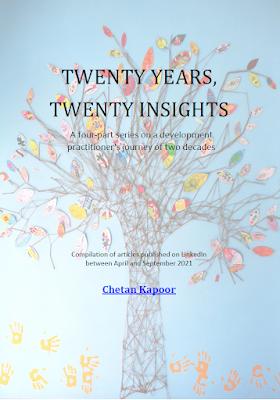Transitioning into the Development Sector? Here’s What To Keep in Mind
With experience spanning 25 years at a leading Indian conglomerate behind her, Vasudha Narasimhan was all set to scale greater heights in her professional career. Having graduated from a premier B-school in 1995, her CV included international assignments and several accolades that had come her way over the years. She was also managing her personal obligations well, with her daughter currently enrolled in medical school. And then, a few months after her 50th birthday, Vasudha decided to give up her well-paying job for one where she would be paid a pittance in comparison, at an NGO working for children’s education.
~~~
Vasudha’s is not an isolated example. There are many like her, who at a similar stage
in their careers have chosen to transition to the social development sector,
with the sole objective of seeking a higher purpose in life. This trend has
taken a significant turn with the pandemic forcing many to re-evaluate their
life priorities. While some are taking recourse to spirituality, others are
contemplating a move towards social development.
As the scenes of the migrant crisis in
the wake of the lockdown and of death and destruction caused by the virus
during the two waves were beamed into our homes each evening, the vast
socioeconomic hiatus that prevails amidst us became apparent to everyone. Those
working in the social sector have been grappling with this divide in areas such
as Education, Health, Livelihoods, and WASH (Water, Sanitation, and Hygiene)
over several decades.
The social sector has always been starved of resources, most notably of committed individuals, when compared to the myriad challenges it presents. The reason is not difficult to pinpoint. While colleges offer a specialization in Social Work (an MSW as it is popularly called), the degree of specialization needed in the sector to address specific challenges requires specialists of a completely different order.
For example, working for persons with disabilities requires trained special educators, psychologists, sign language interpreters etc., who are difficult to find in the space. In all, the trend towards exploring a second innings in the social sector is a welcome development, but the transition can be daunting, even for the most seasoned, unless one goes prepared for what’s in store.
Challenge Your First Principles
A good way to manage the change is to
test the waters as a volunteer with an NGO or a CSR organization. Preferably
the former, as an implementing organization (as opposed to a funding agency or
one that has a support function) is the best place to get hands-on experience
and a feel of the ground. This experience must be an immersive one — of
at least a few weeks — and not just superficial, as the richness
and complexity of the field gets revealed gradually. It is important to go in
with an open mind; preconceived notions often obscure the obvious. Even before
setting foot into the field, doing basic due diligence about the organization
concerned is always a good idea.
Before you finally choose to cross the
Rubicon, an important reconciliation to be made is related to the incentive
structures that prevail in the social sector. Those in the corporate world have
a near-instinctive notion of value and impact, or money and turnaround time.
These can be significantly different in the social spectrum — in the primary
education space, for example, it can take several years before the
“investments” begin to yield the results you were looking for. Be prepared to
challenge your first principles, and to be challenged about them.
Another key reconciliation is the more
obvious one — that wealth can never be your main motivator, and that you must
have the urge to look beyond. Early converts to the sector can continue and
contribute only with the express knowledge that their trajectory will not be
comparable to their corporate counterparts. This
is not to say that earning a living can be sidelined. “The expectation of the
corporate sector and government is that social sector professionals will come
in and do a job at a subsidized salary,” says Ujwal Thakar, the former CEO of Pratham and GiveIndia. “That is an unreasonable expectation in the
long run,” he adds, “because what corporates and governments don’t realize is
that if these experts don’t come and solve these big social problems, the costs
are going to be high for everyone in India”.
As someone who describes his crossover
nearly two decades ago from being the country head of BNP Paribas as
“serendipitous”, Thakar believes that his generation grew up “in India’s
scarcity Raj”, where if you lost a job, it meant the end of the world. “Yet,
even now, when young people [looking to crossover to the social sector] seek
advice, I tell them that passion and commitment to solving social problems is
good, but not enough. They have to think of their financial status before
entering,” says Thakar, who now runs Ujwal Impact Advisers and is also on the
board of several nonprofits.
Corporate converts to the social sector are often disillusioned
by the lack of structure and processes in the NGO world. However, they would do
well to understand that this lack of structure is the natural order of things
in this arena; an element of fluidity and flexibility is essential for any
effective social intervention, as a cookie-cutter approach would almost never
work.
Documents such as process manuals and
standard operating procedures are often hard to find in an NGO, particularly in
smaller ones. However, this is perhaps the most important contribution to NGOs
that people with a corporate background can make, by standardizing those
elements of an organization that are essential to help it scale.
But even the concept of scale as
understood in the world of business and commerce is vastly different from the
social space. At the heart of almost every social intervention is the ideal of
changing human behavior — behavior that has often been entrenched for
centuries. Hence, scaling up an intervention is not just about greater
outreach; it is as much about replicating the intensity of efforts that are
required to engender change in thought and behavior among the intended
beneficiaries of the intervention. For this reason, off-the-shelf solutions
that rely on capital and technology, and not so much on the human element,
often miss the mark in the social sector.
How are professionals making the transition?
The inherent complexity of the
challenges in the sector is what often attracts intrepid individuals towards
it. The social sector has come to be considered as a second innings for many
careers via organizations that facilitate this transition, such as the India Leaders for Social Sector (ILSS). ILSS focuses on strengthening the
leadership talent pool in the social sector by offering immersive programs for
crossover aspirants, of which there have been 240 over the past 3 years. “We
select individuals who can approach the social sector with humility, curiosity,
and a mindset to learn,” says Anu Prasad, the Founder-CEO of ILSS, who is
herself a crossover from the world of finance. “You cannot be hardwired in your
way of thinking [about the social sector] when you enter because it presents a
very complex and challenging set of problems… you need to have deep respect for
the space — even while acknowledging that there is some value you bring to it,”
Anu adds.
Among those who have availed of the
ILSS program is Vasudha, who had enrolled before quitting her corporate job.
Her experience indicates that some crossovers are a product of being pushed
away from the corporate world, more than be pulled by the allure of the social
sector.
From my
perspective, the crossover doesn’t necessarily begin with a deep personal
desire, selflessness, or passion for a social cause. More often than not, the
transition [to the social sector] is triggered by a lack of personal
fulfilment… a midlife questioning of mindless pursuits undertaken in our
everyday lives.
The allure of the social sector’s
purpose-driven lifestyle has not been lost on the youth, who are now taking up
several fellowship programs after completing their college education. As Ujwal
Thakar pointed out, entering the social sector at an early stage is a
relatively tougher decision to make, as these youngsters are willingly giving
up a career path that may bring them more material benefits and comforts.
“Millennials are much more confident of
themselves and their future. However, there aren’t enough platforms to engage
young people interested in experimenting with social change at a young age,”
adds Aditya Natraj, the Founder of Kaivalya Education Foundation, which has
managed over 2500 youngsters since 2008 via the Gandhi Fellowship. “Fellowships are the new MBA,” says Aditya,
who ventured into the social sector back in 2002 after his MBA at INSEAD and a
stint with KPMG. “They are broad, flexible, and branded, which sets people up
for successful careers in creating impact.”
In sum, you have to be an adventurer
and an explorer at heart to successfully crossover into the social sector. A
burning desire to give back to society is a given, and if it comes with an
element of deep compassion and selflessness, the journey is all the more
worthwhile. The opportunity to serve others and to make the world a better
place does not come to most people; for those that it does, it can lead to a
sense of gratification that any other experience can scarcely provide.
This article first appeared in The Bastion on 29 October 2021
Transitioning into the Development Sector? Here’s What You Should Keep in Mind | THE BASTION



Comments
Post a Comment